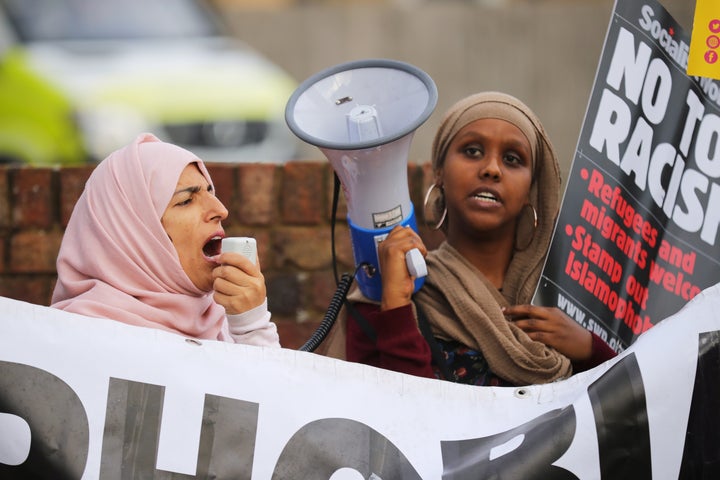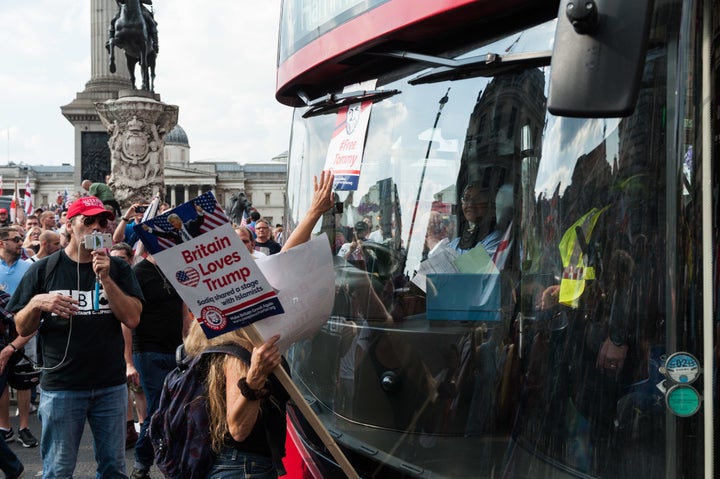
Religious hate crimes have spiked dramatically in England and Wales over the past year, according to newly released data from the U.K.’s Home Office.
Police in England and Wales recorded 8,336 hate incidents that appeared to be motivated by the victim’s religion between April 2017 and March 2018 ― a 40 percent rise from the previous fiscal year, the BBC reports.
More than half of those religion-based hate crimes (52 percent) were directed at people who were perceived to be Muslims.
This is the first time that the annual U.K. government study, published on Tuesday, has included data about the perceived religion of hate crime targets. The Home Office started requiring police officers to collect this information in 2017, realizing that a victim’s perceived and actual religion may not always be the same.
Harun Khan, secretary general of the umbrella group Muslim Council of Britain, said that the new figures should prompt the government to take meaningful action against Islamophobic attacks. “No longer can the Government sit back and watch as the far-right rises, Islamophobia is mainstreamed and vulnerable Muslim communities are attacked,” Khan said in a statement.
The Home Office report suggested that the surge in reported hate crimes was driven by improvements in the way these crimes are identified and recorded by police. But the study also noted that, based on monthly data, hate crimes appeared to spike following the terrorist attacks in London and Manchester in 2017 and the U.K.’s decision to leave the European Union in 2016.
Those spikes seem to support advocacy groups’ claims that attacks on minorities increase after national news events that stimulate public discourse on immigration.
After Muslims, Jews were the next most commonly targeted religious group in England and Wales. Twelve percent of the religiously motivated hate crimes were aimed at people perceived to be Jewish, according to the report.
Both of those groups are the victims of much greater percentages of religious hate crimes than their actual shares of the population in England and Wales. Only about 5 percent of people in those countries identify as Muslim, and a mere 0.5 percent identify as Jewish.
While the rise in hate crimes motivated by religion was the most dramatic, the Home Office also recorded significant upticks in crimes motivated by bias involving gender identity, disability and sexual orientation.
Overall, police recorded 94,098 hate crimes in England and Wales, an increase of 17 percent compared to the previous fiscal year. Religious hate crimes accounted for 9 percent of the total. The overwhelming majority of the hate crimes (76 percent) were motivated by race, the report found.
The government noted that it’s possible for a hate crime to have more than one motivating factor and a single hate crime could be filed under multiple categories.
Also on Tuesday, the Home Office released a separate study called the Crime Survey for England and Wales. It was based on face-to-face interviews with victims and meant to give a broad overview of crime in that region. The report suggested that hate crime incidents had dropped 40 percent over the past decade, as crime overall fell 39 percent. The survey did not look at crimes against children under 16, businesses and certain households.
The Home Office announced Monday that it plans to review its definition of a hate crime. The review will help determine if crimes motivated by ageism, bias against punk and goth subcultures, misogyny and misandry (prejudice against men) should be classified as hate crimes.
Khan said that more needs to be done.
“There has been little action against bullying of Muslim children, minimal funding for security for Muslim institutions (and only during specific periods) and no support to Muslim communities to encourage reporting of hate crime,” he said. “And the list of inaction continues.”

FBI statistics published last November indicate that hate crime reports have also been rising across the pond. Based on data voluntarily submitted by about 15,000 law enforcement agencies in the U.S., the FBI documented 6,121 hate crime incidents in 2016, up 5 percent from the previous year. About 21 percent were prompted solely by religious bias, most of it targeted toward Jews and Muslims.
The hate crime statistics gathered by American advocacy groups tend to be higher, suggesting that the FBI’s numbers don’t show the whole picture of religious hate crimes in the U.S.
